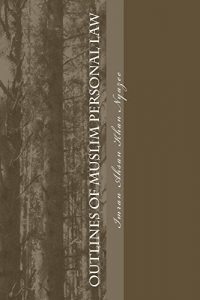This small book is exactly what the title says it is: an outline. It
is meant as a convenient handbook for the student. A more detailed
``code'' is being written to meet the needs of lawyers and researchers, and
will hopefully be published soon.
The purpose of this small book is to lay down the traditional law of
Islam first, especially the law of the Hanafi school, and then to
identify the points on which this law has been altered by statute or
by case law. The purpose is not to identify the law first and then to
fill the gaps with traditional law, which is what is done for the
common law.
On a few occasions, this outline differs from the position taken
by other publications, especially Mulla's Code. The reason is that the
position taken by such works, in these cases, is not in conformity
with the traditional Islamic law. The differences have been indicated
along with the position stated in such codes. Nevertheless, these
occasions are not too many and the reader will not feel that there is
a major departure from the earlier literature in the field.
The outline also indicates those points where a decision taken by
the learned courts is totally contrary to the rulings of traditional
law. Reasons for disagreement have been indicated very briefly as a
small outline cannot be burdened with detailed discussions. Despite
its concise nature, the book has been quoted by some courts, including
the Supreme Court of Pakistan.
is meant as a convenient handbook for the student. A more detailed
``code'' is being written to meet the needs of lawyers and researchers, and
will hopefully be published soon.
The purpose of this small book is to lay down the traditional law of
Islam first, especially the law of the Hanafi school, and then to
identify the points on which this law has been altered by statute or
by case law. The purpose is not to identify the law first and then to
fill the gaps with traditional law, which is what is done for the
common law.
On a few occasions, this outline differs from the position taken
by other publications, especially Mulla's Code. The reason is that the
position taken by such works, in these cases, is not in conformity
with the traditional Islamic law. The differences have been indicated
along with the position stated in such codes. Nevertheless, these
occasions are not too many and the reader will not feel that there is
a major departure from the earlier literature in the field.
The outline also indicates those points where a decision taken by
the learned courts is totally contrary to the rulings of traditional
law. Reasons for disagreement have been indicated very briefly as a
small outline cannot be burdened with detailed discussions. Despite
its concise nature, the book has been quoted by some courts, including
the Supreme Court of Pakistan.



